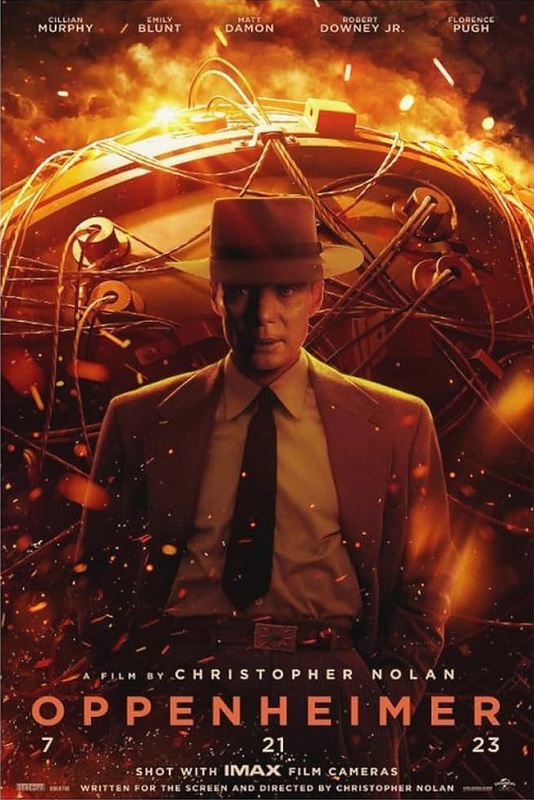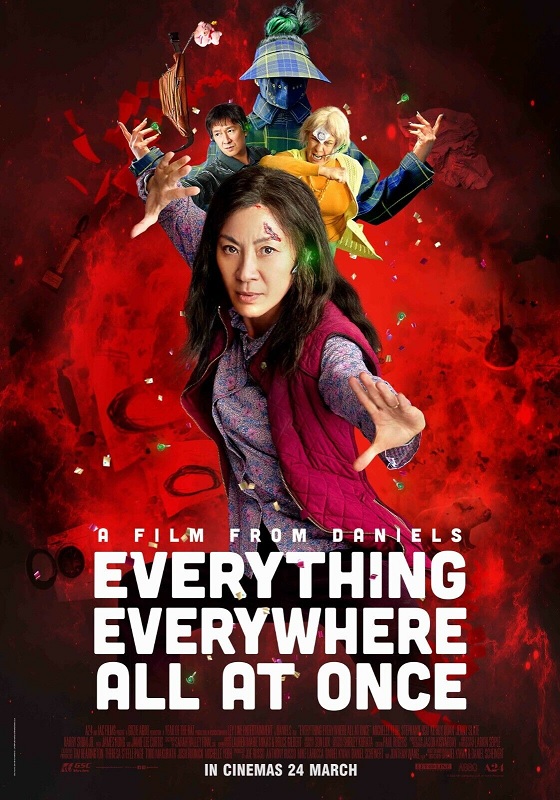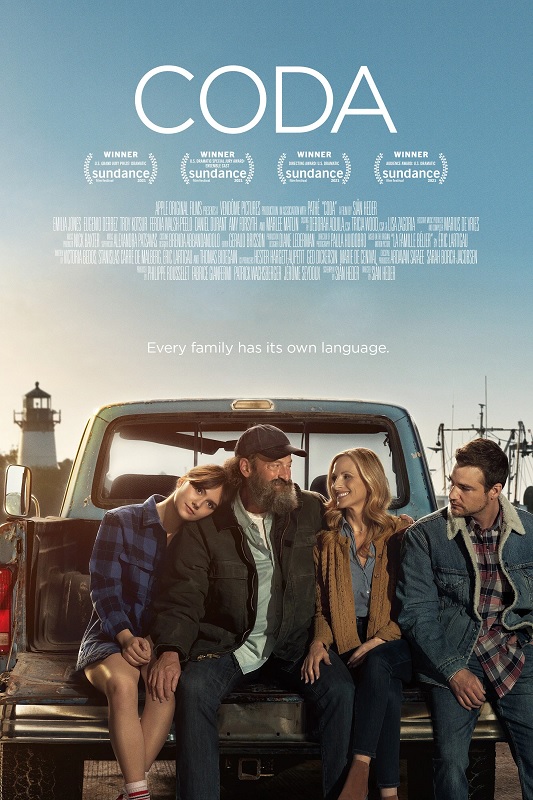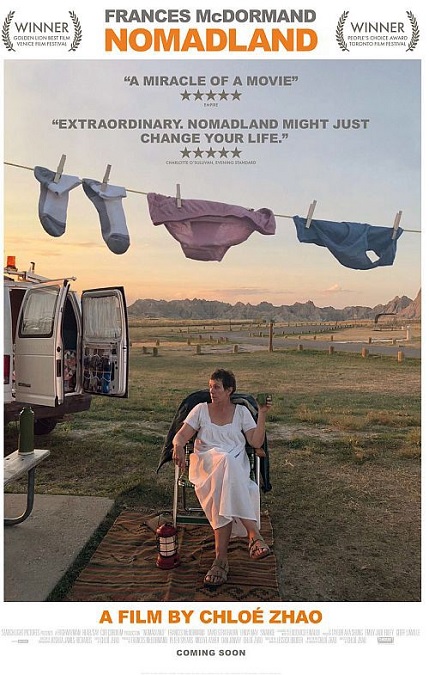


Oppenheimer – 2023
There is a lot to say about Oppenheimer. It was a very good movie, and I can see why it was nominated for Best Picture. I can understand why it won. It was a dramatized biopic about the career of the man who was one of the driving forces behind the creation of the first nuclear bombs that destroyed Hiroshima and Nagasaki, Japan. It was an event that had an effect on the course of human history, and thus, he was a man who literally changed the world forever in ways that, even now, we might not be able to foresee. It looked at his personal relationships, his professional relationships, and his involvement in events that changed the world in both bad and good ways. He was a brilliant theoretical physicist, and at times, a complicated and tortured man. In other words, he was the perfect subject for the creation of a Best Picture winning movie.
Oppenheimer was nominated for twelve Academy Awards, and took home seven. Most notable, Christopher Nolan won for Best Director, Cillian Murphy won for Best Actor, and Robert Downey Jr. won for Best Supporting Actor. The film also took home Oscars for Cinematography, Film Editing, and Best Original Score. The nominations it didn’t win were for Emily Blunt in the Best Supporting Actress category, Best Adapted Screenplay, Best Costume Design, Best Makeup and Hairstyling, Best Production Design, and Best Sound. That’s a pretty impressive list.
As seems to be the trend in recent years, the story was told nonlinearly. It kept jumping back and forth between three plot lines. The main story was that of J. Robert Oppenheimer, played by Murphy, the director of the Los Alamos Laboratory that developed the nuclear weapons. This story, which began in 1926, followed a fairly linear path, but it was intercut with scenes from the 1959 Senate Confirmation hearings of Rear Admiral Lewis Strauss, who, as depicted by the film, was secretly a rival of Oppenheimer, seeking revenge for professional and personal sleights, both real and imagined, and a private security hearing in front of a Personnel Security Board concerning Oppenheimer’s Q clearance, in which his loyalty to America was questioned. It is later revealed that this hearing was orchestrated by Admiral Strauss, in order to discredit Oppenheimer.
The main story was filmed in color, while the senate hearings that took place later were in black and white. Director Christopher Nolan, who also won the Best Director Oscar, said that this was to tell a more objective story from a different character’s perspective. But I think this device also served to more firmly separate the stories that were being told simultaneously. Each of the three plot-lines were interesting in their own right, and I’d bet that each of them could have made an interesting film by themselves. But the way that Nolan spliced them together, with ideas and revelations that overlapped and had relevance across the board, was absolutely brilliant.
Interesting note: Many critics have called Oppenheimer a masterpiece. It has been lauded as the best of the director’s films. To quote Wikipedia, “Steven Soderbergh said of the film, ‘Oppenheimer is a real accomplishment. I read somewhere that Chris [Nolan] implied that this is the movie he’s been building toward, and I think he’s right. And I’m thrilled that it’s a massive hit.’”
I think it is fair to say that not only did the film tell an interesting story in an incredibly entertaining way, but it also had a certain amount of historical and social relevance. It was almost a cautionary tale about the dangers of opening a Pandora’s Box. What are the moral consequences of creating such a devastating device as a nuclear bomb? Did it save more lives than it destroyed? And what would the creation of such a lethal device do to the psyche of the man who developed it? And was Oppenheimer, the man, the scientist, to be praised for his work, or condemned for it?
That’s where the real drama of the movie came out, and the fantastic cast really stepped up to the plate. That’s why three members of the cast were nominated for acting awards, and why two of them won. In the lead was Cillian Murphy, playing the title character. Not only did he look like the real man he was portraying, but he nailed the pathos of the character, bringing out the inner workings of the mind of the man, from the way he behaved, to the way he reacted to the events in which he was participating. Even when he was saying nothing, Murphy allowed us to hear what Oppenheimer was thinking, with his posture, his eyes, his facial expressions.
Robert Downey Jr. has had a long career, a problem with drugs and run-ins with the law that ruined him professionally, and a comeback that turned him into one of the highest-payed and most sought after actors of his generation. Most people today know him from his work as Iron Man in the MCU franchise, a role that has effectively ended. But here he proves, yet again, how good an actor he really is. But I have to note the similarities between his role here as Admiral Strauss and Tony Stark. Both characters are rich and powerful in their fields. They both have an ego that often gets the better of them. But as Strauss, Downey brought out a pettiness and a vindictiveness Stark didn’t possess. The movie almost portrays Strauss as a behind-the-scene villain, the unapologetic Salieri to Oppenheimer’s Mozart.
Then there were the two leading ladies of the movie, Florence Pugh and Emily Blunt. Blunt played Oppenheimer’s wife, Kitty, Pugh, his mistress, Jean Tatlock, a psychiatrist and member of the Communist Party USA, who committed suicide after Oppenheimer ended his relationship with her. They both did a great job, but Blunt stood out more, simply because her character carried a more significant portion of the film’s drama. She played the woman behind the man, the one who supported him and occasionally had to push him onto the path she knew he had to follow. She gave us Kitty’s sense of guilt for her own part in her husband’s creation, and her clear respect for his genius, which sometimes seemed to border on fear. Blunt really gave us a fantastic performance.
And there were even more big names in the cast, names like Matt Damon, who played General Leslie Groves, the military officer who was the director of the Manhattan Project. He was hard and staunch in proper military fashion, and Damon did an amazing job. There was Josh Hartnett, Casey Afleck, Rami Malek, Kenneth Branagh, Jason Clarke, James D’Arcy, Alden Ehrenreich, Matthew Modine, and even a single memorable scene with Gary Oldman playing President Harry S. Truman. They all did a great job.
For me, I think Ehrenreich and Clarke both really stood out. The former played Admiral Strauss’ Senate aide, who, when Strauss’ true motives were revealed, began to turn against his boss. It must have been difficult for him to play all his scenes against Robert Downey Jr., who was at the top of his game, but he really stepped up to the plate and did a fine job. The latter played Roger Robb, the main interrogator in the private security hearing, who was appointed by Strauss, with the agenda of discrediting Oppenheimer. He was particularly good in the scene where he questions Kitty. She was great in that scene, too!
Interesting Note: Another paraphrased quote from Wikipedia: “The casting process was so secretive that some cast members did not know which role they would be playing until they signed on. Downey, Damon, and Blunt took pay cuts, with each earning only $4 million in lieu of their usual $10–20 million salary. Downey would later describe Oppenheimer as “the best film” in which he has appeared to date. When Blunt was offered the role of Kitty, she enthusiastically accepted, then contacted Murphy to ask what working with Nolan would be like. Damon was taking a break from acting as a result of negotiations with his wife in couples therapy, but signed on to Oppenheimer as he had reserved one exception: if Nolan offered him a role in a film.”
Now I have to mention the film’s score. Composer Ludwig Göransson put together a score that was both structured and fluid at the same time. There was music that created tension, even in scenes that shouldn’t have any because we all know, historically, what was going to happen. There were passages of the score that reminded me vaguely of the music of Phillip Glass. There were repeating circular patterns of counterpoint that were perfect for setting moods for the scenes, and building a sense of expectation that was so effective. I am glad that Göransson took home the Oscar for Best Original Score. He deserved it.
As with all movies that are based on real events, I like to do a little reading to determine just how accurate the film was. In the case of Oppenheimer, I am happy to report that it was apparently quite accurate. The differences were subtle. An embellishment here, an omission there, a changed character here, an altered reaction there. For example, President Truman did indeed call Oppenheimer a crybaby, but it was in a letter at a later time, not directly after his meeting with the scientist, and within earshot as he exited the Oval Office.
But aside from those small things, Nolan, who wrote the screenplay, remained very true to the real events of the story. It was based on a book about Oppenheimer by authors Kai Bird and Martin J. Sherwin, called American Prometheus, Prometheus being the Greek figure who stole Fire from the Gods and gave it to mankind. I’ve no doubt that the film’s historical accuracy went a long way to impress the Academy voters.
Something else I found fascinating were the film’s visual effects. Nolan is known for his preference for practical effects instead of CGI effects, something I happen to agree with. I have no problem with CGI, as it has gotten to a point where most computer generated imagery looks perfectly real. It’s so good that most of the time you don’t even see it or recognize that it is a digital effect. But I have a respect for filmmakers that find creative ways to create in-camera illusions. If executed properly, they have a solidity to them that, at times, even perfectly executed CGI effects don’t seem to have. And I am impressed by the cleverness and ingenuity it takes to make them work.
One of my favorite scenes in the movie is the first test of a nuclear bomb in the New Mexico desert. Again, we all know that the test was successful, but it was interesting how Nolan was able to put us all into the event, like we were more than just an audience. We were participants. The excitement, the hopefulness, the fear, of what was being done, and why. The cuts between the different groups of people watching the test, the music, and the persistent countdown, made for a masterfully crafted scene. And when the explosion came, the music stopped and the fire and destruction is seen in near absolute silence. All we can hear is quiet breaths from the observers.
The silence lasted for a full minute as we see the explosion from different angles. Finally, we hear a note from the orchestra creep into the texture of the scene. After another thirty seconds, we hear Oppenheimer quote, “And now I am become death, destroyer of worlds.” About a minute and forty seconds after the initial detonation, we finally hear the boom and see the mushroom cloud in all its terrible glory. The tension was released and we all reveled in the success of the test. But we also feel a certain amount of guilt because we know that the genie is now out of the bottle, and can never be put back inside.
Interesting note: Digital compositing was used for the Trinity scene to add multi-layers to the explosion which was shot in a multifaceted viewpoint. though the explosion itself, was done as a practical effect.
Because the film was a biopic of Oppenheimer’s career, it also had to deal with the times in which he lived. It explored the social implications of both Soviet and US Communism, the threat of WWII, the arms race with Nazi scientists who were also attempting to develop nuclear weapons, and the inevitable slippery slope that turned into the Cold War with the Soviets. And then it dealt with the national political backlash of Oppenheimer’s work and his legacy. Oppenheimer did what he had to do, but how was he treated once he had done it?
But when it comes down to it, it was just an enjoyable film to watch. I’m not generally interested in historical biographies, but Nolan put it together in such a way as to make it engaging. It was a story that held my interest for the entire three hour run-time. He, and the incredible cast of actors did a great job of making the dry subject matter seem palatable. It was a slice of history about which I didn’t know I needed to know.
And both critics and audiences agree. The film had a box-office take of over $964 million on a production budget of only $100 million. That in itself is pretty impressive. And some regard the film as not only the best picture of the year, but as one of the best and most important films of the century. I don’t know if that’s true or not. What I do know is that I enjoyed the movie from beginning to end, and I think it really deserved all the accolades and awards it has been given.






































